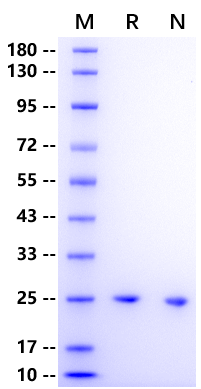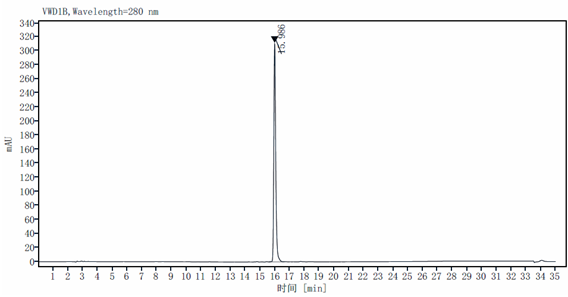His29-Ser209, with N-terminal 6*His MHHHHHHPIPDSSPLLQFGGQVRQRYLYTDDAQQTEAHLEIREDGTVGGAADQSPESLLQLKALKPGVIQILGVKTSRFLCQRPDGALYGSLHFDPEACSFRELLLEDGYNVYQSEAHGLPLHLPGNKSPHRDPAPRGPARFLPLPGLPPALPEPPGILAPQPPDVGSSDPLSMVGPSQGRSPSYAS
25 kDa(Reducing)
>97% by SDS-PAGE & RP-HPLC
20mM Tris, 100mM NaCl, pH7.5
Reconstitute at 0.1-1 mg/ml according to the size in ultrapure water after rapid centrifugation.
· 12 months from date of receipt, lyophilized powder stored at -20 to -80℃.
· 3 months, -20 to -80℃ under sterile conditions after reconstitution.
· 1 week, 2 to 8℃ under sterile conditions after reconstitution.
· Please avoid repeated freeze-thaw cycles.
Fibroblast growth factor 21 (FGF-21) is a pleiotropic hormone considered as a major regulator of energy homeostasis. FGF-21 is mainly secreted by the liver, but it may also be expressed in skeletal muscle. In this sense, FGF-21 protein expression is induced by insulin in C2C12 myocytes, and FGF21 mRNA is upregulated by hyperinsulinemia in skeletal muscle in young healthy men. Moreover, it has been suggested that FGF-21 is a signal secreted by the skeletal muscle to communicate with adipose tissue under stress conditions. FGF21 has been shown to be a major regulator of hepatic lipid metabolism, with FGF-21 overexpressing mice being resistant to diet-induced obesity. Interestingly, recent studies suggest that FGF21 may exert anti-inflammatory actions in the pancreas, heart, and skeletal muscle. A reduction in the JNK and NF-κB signaling pathways has been proposed as the potential mechanism implicated in the FGF-21 anti-inflammatory effects.

Measured in a cell proliferation assay using NIH-3T3 mouse embryonic fibroblast cells. The EC50 this effect is less than 0.5μg/ml in the presence of 1.5 μg/ml recombinant human Klotho β.

